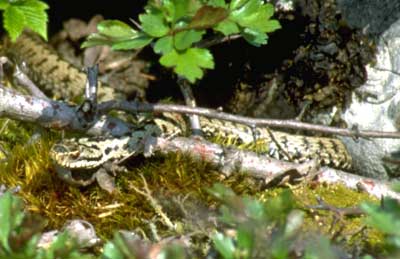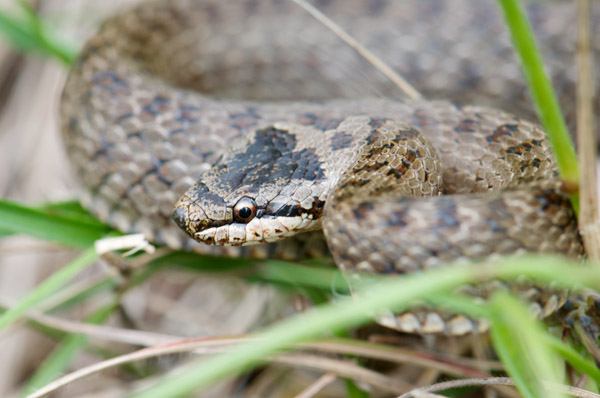
| phylogeography, phylogeny and systematics | population genetics and ecology | conservation and alien species |
Population genetics
The understanding of the genetic structure between and within populations is a major concern for the conservation biology. Indeed, inbreeding or inbreeding drift in small populations can only be compensated by migrations between different demes. By using molecular markers such as microsatellites, the migration can be evaluated and signs of genetic diversity decrease detected. Moreover, inbreeding or genetic diversity are often related fitness parameters (such as survival, neonate survival or fecundity), but only a limited number of study have compared those parameters in the field.
 The
investigation within Vipera berus populations
did not reveal strong genetic diversity reduction in the populations of the
Jura Mountains, execpt for one which has suffered a strong bottleneck
about 100 years ago due to culling (at that time, the destruction of
vipers was actively supported by local authorites...). The genetic diversity
seems to be sufficient in each population to avoid population crash due to
lack of diversity, as observed in Smygehuk (see Thomas Madsen's works). However,
high genetic differentiation was detected between all the populations, even
between populations separated by only 1-2 km. Thus, the gene flow seems to
be very limited between adder populations.
The
investigation within Vipera berus populations
did not reveal strong genetic diversity reduction in the populations of the
Jura Mountains, execpt for one which has suffered a strong bottleneck
about 100 years ago due to culling (at that time, the destruction of
vipers was actively supported by local authorites...). The genetic diversity
seems to be sufficient in each population to avoid population crash due to
lack of diversity, as observed in Smygehuk (see Thomas Madsen's works). However,
high genetic differentiation was detected between all the populations, even
between populations separated by only 1-2 km. Thus, the gene flow seems to
be very limited between adder populations.
On the opposite, the gene flow is important for other European Colubrids, such as the grass snake (Natrix natrix) or the smooth snake (Coronella austriaca). Indeed, these species did not show genetic differentiation between populations spearated by about 10 km (or more) and the reduction of the gene flow seems to be proportional to the distance between populations (at least within N. natrix populations along the Aar river).
• FERCHAUD A.-L., LYET A., CHEYLAN M., ARNAL V., BARON J.-P., MONGELARD C. & , URSENBACHER, S. (2011) High genetic differentiation among French populations of the Orsini's meadow viper (Vipera ursinii ursinii) based on mitochondrial and microsatellite data: Implications for conservation management, Journal of Heredity 102(1) 67-78
Landscape genetics
Landscape genetics is a recent discipline combining population genetics and landscape information. This approach allows a better understanding of the lanscape elements fragmentaing populations or favouring the dispersion. An exhaustive sampling, a good evaluation of population genetic structure (e.g. evaluated using microatellite makers) and a comprehensive knowledge of the study area (e.g. Geographic Information System GIS) are needed to obtain adequate results.
First attempts with reptiles have been conducted for the slow worm in the "La Côte" (between Lausanne and Geneva, Switzerland) region.
Reproductive strategy
Fitness of animals is directly related to their survival and their reproductive success. By the lack of parental care and the absence of social bonds between mating couples, snakes are ideal model for studdying parameters that are involved in the reproductive success. For example, in the adder, a direct relationship between the length of the male and his reproductive success was observed. Moreover, multiple paternity frequently occurs in this species and the reason of such behaviour by the female must still be studied.
• URSENBACHER S., ERNY C. & FUMAGALLI L. (2009) Male
reproductive success and multiple paternity in wild, low density populations
of the adder (Vipera berus), Journal of Heredity 100 (3) 365-370, pdf